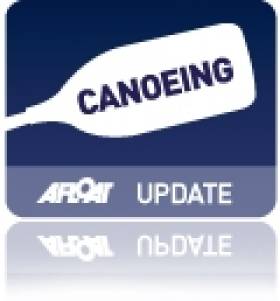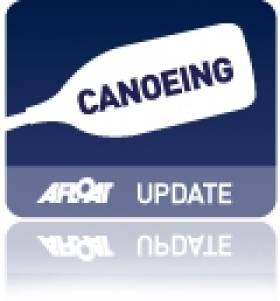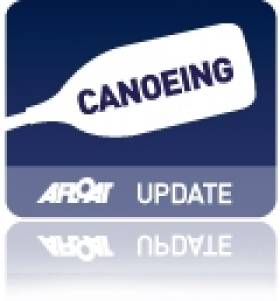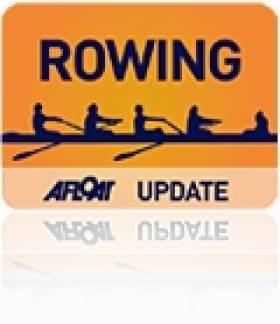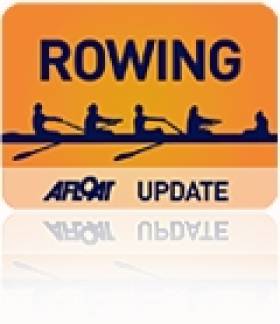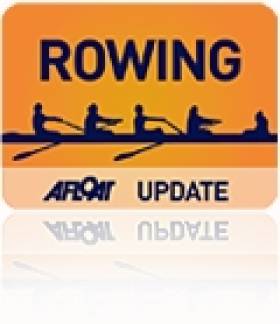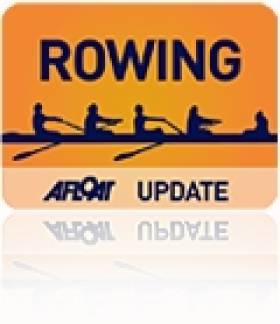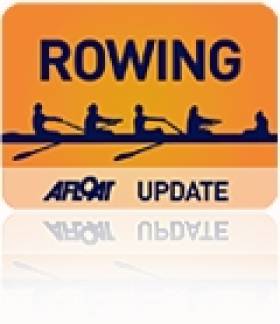Displaying items by tag: Ireland,
#CANOEING: Newly-qualified Olympian Andrzej Jerzieski finished fifth in the B Final (14th overall) in the C1 200 metres at the Canoe Sprint World Cup in Poznan in Poland today.
Canoe Sprint World Cup, Poznan, Day Two (Irish interest)
Saturday
Men
C1 200 – Heat Three (1-7 and next best time to Semi-Final) 7 A Jezierski 48.652. Semi-Final (1-2 and next best time to A Final; 3-4 to B Final): 4 Jezierski 42.663.
K1 1,000m – B Final: 4 B Watkins 3:53.405
K2 200 – Heat Two (1-6 and next 3 best times to Semi-Final): 8 P Egan, M Majchrzak) 37.239. Heat Four: 7 S Marchetti, V Peirce 35.798. Semi-Final: 8 Marchetti, Peirce 35.776.
Women
K1 500m – C Final: 7 J Egan 2:10.730.
Sunday
Men
C1 200m – B Final: 5 A Jezeierski 44.204
Women
K1 5,000m – Final: Egan did not finish.
B Final Place for Jezierski in Canoe Sprint World Cup
CANOEING: New Ireland star Andrzej Jezierski qualified for the B Final at the canoe sprint World Cup in Poznan in Poland. Jezierski finished fourth in his semi-final, just over three tenths of a second off the second place which would have put him in the A Final. Jezierski booked his place for the Olympic Games at the same venue in the Olympic Qualifier on Thursday.
Canoe Sprint World Cup, Poznan, Day Two (Irish interest)
Men
C1 200 – Heat Three (1-7 and next best time to Semi-Final) 7 A Jezierski 48.652. Semi-Final (1-2 and next best time to A Final; 3-4 to B Final): 4 Jezierski 42.663.
K1 1,000m – B Final: 4 B Watkins 3:53.405
K2 200 – Heat Two (1-6 and next 3 best times to Semi-Final): 8 P Egan, M Majchrzak) 37.239. Heat Four: 7 S Marchetti, V Peirce 35.798
Women
K1 500m – C Final: 7 J Egan 2:10.730.
Jezierski Qualifies Ireland Boat for Olympic Games
# CANOEING; Ireland booked a place for a third canoeist at the Olympic Games as Andrzej Jezierski fought through difficult conditions to take second place in the Olympic Qualifier in Poznan in Poland today. The Polish man who lives and works in Cork came in just over half a second behind Hagara Lubomir of Slovakia.
Jenny Egan failed to make the final in the K1 200 metres, but there are still hopes that she will make it through in the K1 500m in which she finished seventh earlier in the day.
European Canoe Sprint Olympic Qualifier – Day Two (Irish interest)
Men – C1 200m – A Final (First Two Qualify): 1 Slovakia (L Hagara) 42.518, 2 Ireland (A Jezierski) 43.034; 3 Czech Republic (M Fuksa) 43.522, 4 Germany (S Kiraj) 43.746, 5 Romania 44.186, 6 Latvia 45.202, 7 France 45.366, 6 Georgia 45.594, 9 Hungary disqualified.
Women, K1 500m – A Final: 1 Russia (Y Kachalova) 2:00.037, 2 Norway (MV Larsen) 2:01.281, 3 Poland (K Naja) 2:01.769, 4 Austria (AR Lehaci) 2:02.801, 5 Romania (R Borha) 2:03.317, 6 Spain (A Portela) 2:03.701, 7 Ireland (J Egan) 2:04.061, 8 Sweden (A Roger) 2:05.377, 9 Netherlands (E Haaze) 2:06.489.
K1 200 – Semi-Final: 1 Italy 45.253; 6 Egan 48.641.
Craig Books Her Place in Canoe Slalom at London 2012
#CANOEING: Hannah Craig is set to represent Ireland at the Olympic Games in London in the K1 racing kayak. The Antrim woman finished 25th at the European Canoe Slalom Championships in Augsburg today, the highest position occupied by a boat from a country not already qualified. Elise Chabbey of Switzerland took the second place on offer by finishing 32nd.
Canoe Slalom European Championships, Augsburg, Day Two
Women
K1 (racing kayak) Heats (1st and 2nd runs): 1 Germany (J Schornberg) 99.26 seconds (2nd run); 25 Ireland (H Craig) 105.69 (2nd run); 32 Switzerland (E Chabbey) 109.32 (2nd run) 47 Ireland (H Barnes) 112.14 (1st run); 40 Ireland (A Conlon) 120.18 (1st run).
Lambe Fifth in A Final at World Cup
#ROWING: Claire Lambe finished fifth in the A Final of the lightweight single sculls at the World Cup in Belgrade today. The 21-year-old Dubliner struggled to stay with the hot pace set by Michaela Taupe-Traer of Austria and Kathryn Twyman of Britain, who took the gold and silver medals. Pamela Weisshaupt of Switzerland took the bronze.
World Cup, Belgrade – Day Two (Irish interest)
Men
Lightweight Double Scull – C Final (places 13 to 18): 1 Austria Two 6:24.17, 2 Austria Three 6:24.21, 3 Slovenia Two 6:26.16, 4 Croatia 6:26.66, 5 Ireland (M O’Donovan, N Kenny) 6:26.67, 6 Austria One 6:27.57.
Lightweight Single – C Final: Ireland (M Maher) did not start.
Women
Single Scull – A/B Semi-Final (First Three to A Final; rest to B Final): 1 China (X Zhang) 7:18.59, 2 Czech Republic (M Knapkova) 7:18.81, 3 Ireland (S Puspure) 7:27.27; 4 Estonia (K Pajusalu) 7:32.15, 5 Serbia Two (I Filipovic) 7:43.16, 6 Ukraine (N Huba) 7:48.97.
Lightweight Single Scull – Repechage (First Four to A/B Semi-Final): 1 Switzerland (P Weisshaupt) 7:55.81, 2 Ireland (C Lambe) 7:57.35, 3 Sweden One (C Lilja) 7:58.63, 4 Croatia (H Pavkovic) 8:01.57; 5 Sweden Two (L Kalstroem) 8:06.42. A Final: 1 Austria (M Taupe-Traer) 7:48.45, 2 Britain (K Twyman) 7:50.11, 3 Switzerland (P Weisshaupt) 7:52.83; 4 Sweden 8:03.47, 5 Ireland 8:03.47, 6 Croatia 8:09.51.
#ROWING: Ireland's Sanita Puspure fought her way into the A Final of the single scull at the World Cup in Belgrade this afternoon. With Xiuyun Zhang and world champion Mirka Knapkova colonising the first two places, it became a race between Puspure and Kaisa Pajusalu for the crucial third qualifying spot. A push in the third quarter was decisive for Puspure, who held off a late challenge from Pajusalu and had almost five seconds to spare on the line. Pajusalu, a former world champion at under-23 level, was 12th in the world last year in this class.
World Cup, Belgrade – Day Two (Irish interest)
Men
Lightweight Double Scull – C Final (places 13 to 18): 1 Austria Two 6:24.17, 2 Austria Three 6:24.21, 3 Slovenia Two 6:26.16, 4 Croatia 6:26.66, 5 Ireland (M O’Donovan, N Kenny) 6:26.67, 6 Austria One 6:27.57.
Lightweight Single – C Final: Ireland (M Maher) did not start.
Women
Single Scull – A/B Semi-Final (First Three to A Final; rest to B Final): 1 China (X Zhang) 7:18.59, 2 Czech Republic (M Knapkova) 7:18.81, 3 Ireland (S Puspure) 7:27.27; 4 Estonia (K Pajusalu) 7:32.15, 5 Serbia Two (I Filipovic) 7:43.16, 6 Ukraine (N Huba) 7:48.97.
Lightweight Single Scull – Repechage (First Four to A/B Semi-Final): 1 Switzerland (P Weisshaupt) 7:55.81, 2 Ireland (C Lambe) 7:57.35, 3 Sweden One (C Lilja) 7:58.63, 4 Croatia (H Pavkovic) 8:01.57; 5 Sweden Two (L Kalstroem) 8:06.42.
Dramatic Finish in Ireland Race at World Cup Rowing
#ROWING: In a race with a dramatic finish, Ireland’s lightweight double of Mark O’Donovan and Niall Kenny finished fifth in the C Final of the lightweight men’s double at the World Cup Regatta in Belgrade this morning. This placed them 17th overall.
The Ireland crew held third behind two Austrian doubles until a final charge by Slovenia and surprise packets Croatia saw both boats pass them. Croatia were just one hundredth of a second ahead of the Irish on the line.
Michael Maher did not start his C Final in the men’s lightweight single scull.
World Cup, Belgrade – Day Two (Irish interest)
Men
Lightweight Double Scull – C Final (places 13 to 18): 1 Austria Two 6:24.17, 2 Austria Three 6:24.21, 3 Slovenia Two 6:26.16, 4 Croatia 6:26.66, 5 Ireland (M O’Donovan, N Kenny) 6:26.67, 6 Austria One 6:27.57.
Lightweight Single – C Final: Ireland (M Maher) did not start.
Women
Lightweight Single Scull – Repechage (First Four to A/B Semi-Final): 1 Switzerland (P Weisshaupt) 7:55.81, 2 Ireland (C Lambe) 7:57.35, 3 Sweden One (C Lilja) 7:58.63, 4 Croatia (H Pavkovic) 8:01.57; 5 Sweden Two (L Kalstroem) 8:06.42.
Lambe Secures A Final Place at World Cup Rowing
#ROWING: Claire Lambe competed well to finish second in her repechage this morning and qualify for this afternoon’s A Final of the lightweight single scull at the World Cup Regatta in Belgrade. The 21-year-old Dubliner was always in the thick of the action and led in the closing stages before she was passed by Pamela Weisshaupt of Switzerland in the final 250 metres. Weisshaupt (33) was world champion in this discipline in 2008 and 2009 and silver medallist last year.
World Cup, Belgrade – Day Two (Irish interest)
Women
Lightweight Single Scull – Repechage (First Four to A/B Semi-Final): 1 Switzerland (P Weisshaupt) 7:55.81, 2 Ireland (C Lambe) 7:57.35, 3 Sweden One (C Lilja) 7:58.63, 4 Croatia (H Pavkovic) 8:01.57; 5 Sweden Two (L Kalstroem) 8:06.42.
#ROWING: Sanita Puspure was Ireland's success story on the first day of the World Cup Regatta in Belgrade today. She won a battle with Norway’s Tale Gjoertz to finish second behind local woman Iva Obradovic in her heat and qualify directly for the A/B Semi-Final of the single scull.
The three other Ireland crews in action all face into repechages. Mark O’Donovan and Niall Kenny finished fourth in their heat of the lightweight double sculls, over 10 seconds behind the winners, China. In the lightweight single sculls, Michael Maher finished fifth in his heat and Claire Lambe second in hers.
World Cup Regatta, Belgrade – Day One (Irish interest)
Men
Single Scull – Heat Two (Winner to A/B Semi-Final): 1 Britain (A Campbell) 6:57.43.
Lightweight Double Scull – Heat Four (Winner to A/B Semi-Finals; rest to Repechages): 1 China (C Wu, F Zhang) 6:22.40, 2 Greece 6:26.19, 3 Austria Four 6:32.40, 4 Ireland (M O’Donovan, N Kenny) 6:32.96, 5 Austria Two 6:37.47.
Lightweight Single Scull – Heat One (First Three to A/B Semi-Final; rest to Repechage): 1 France Two 7:07.89, 2 Norway Three 7:11.01, 3 Greece 7:11.15, 4 Egypt 7:18.82, 5 Ireland (M Maher) 7:24.05.
Women
Single Scull – Heat Three (First Two Directly to A/B Semi-Finals; rest to repechages): 1 Serbia (I Obradovic) 7:29.83, 2 Ireland (S Puspure) 7:34.28; 3 Norway (T Gjoertz) 7:34.70, 4 Lithuania (D Vistartaite) 7:58.31, 5 Austria (L Farthofer) 8:01.66.
Lightweight Single Scull – Heat One (Winner to A Final; rest to Repechage): 1 Britain (K Twyman) 7:49.69; 2 Ireland (C Lambe) 7:54.91, 3 Austria Two 8:00.09, 4 Croatia 8:00.85.
Irish Olympian O'Neill to Represent New Zealand in London
ROWING: Sean O’Neill from Co Limerick will represent New Zealand at the Olympic Games in London in the men’s four – the same boat class in which he rowed for Ireland in Beijing four years ago. O’Neill, who is now 31, moved to New Zealand in his teens, originally to play rugby, but he took up rowing there and won a number of national titles. He settled there and trialled for New Zealand in 2006, but then returned to Ireland and established himself in the national team. He was in the stroke seat of the Ireland (heavyweight) four which finished 10th in Beijing. He returned to New Zealand and has become a regular in the national team.
NEW ZEALAND OLYMPIC ROWING TEAM FOR BOATS ALREADY QUALIFIED FOR LONDON 2012
Men’s Single Scull Mahé Drysdale Coach – Richard Tonks
Women’s Single Scull Emma Twigg Coach – Richard Tonks
Men’s Pair Eric Murray and Hamish Bond Coach – Richard Tonks
Women’s Quadruple Scull Eve Macfarlane, Fiona Bourke, Louise Trappitt and Sarah Gray Coach – Richard Tonks
Women’s Pair Juliette Haigh and Rebecca Scown Coach – John Robinson
Women’s Lightweight Double Scull Julia Edward and Louise Ayling Coach – John Robinson
Men’s Double Scull Nathan Cohen and Joseph Sullivan Coach – Calvin Ferguson
Men’s Lightweight Double Scull Peter Taylor and Storm Uru Coach – Calvin Ferguson
Women’s Double Scull Fi Paterson and Anna Reymer Coach – Gary Hay
Men’s Quadruple Scull Robbie Manson, Matthew Trott, Michael Arms and John Storey Coach – Mike Rodger
Men’s Four Sean O’Neill, Chris Harris, Jade Uru and Tyson Williams Coach – Dave Thompson
NEW ZEALAND ROWING TEAM FOR BOATS TO RACE AT LAST CHANCE QUALIFYING REGATTA FOR LONDON 2012
Men’s Lightweight Four Curtis Rapley, James Lassche, Graham Oberlin-Brown, Duncan Grant Coach – Dave Thompson
Men’s Eight Richard Harrison, Hamish Burson, Tobias Wehr-Candler, Adam Tripp, Ian Seymour, Ben Hammond, Fergus Fauvel, David Eade and cox Ivan Pavich. Coach – Ian Wright




























